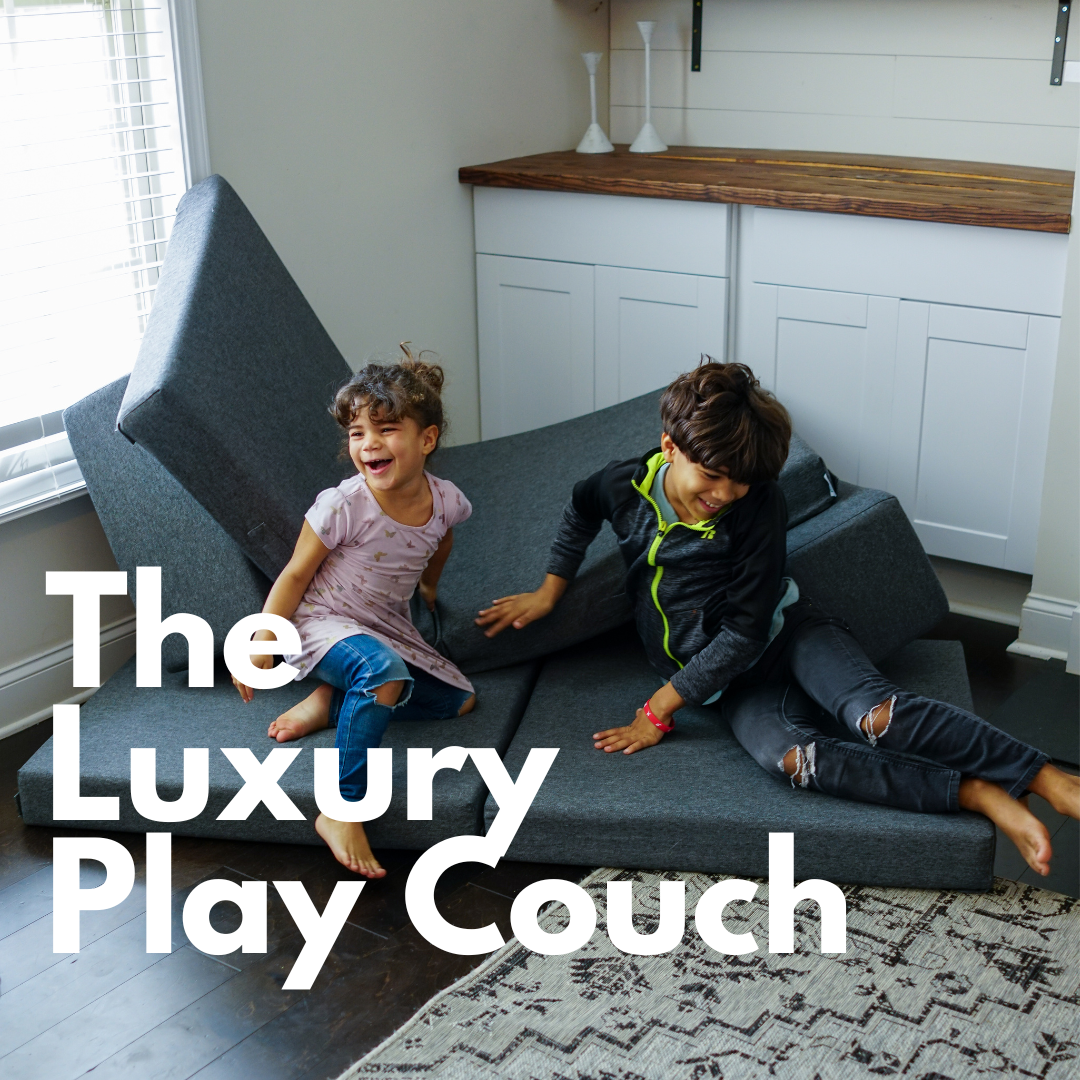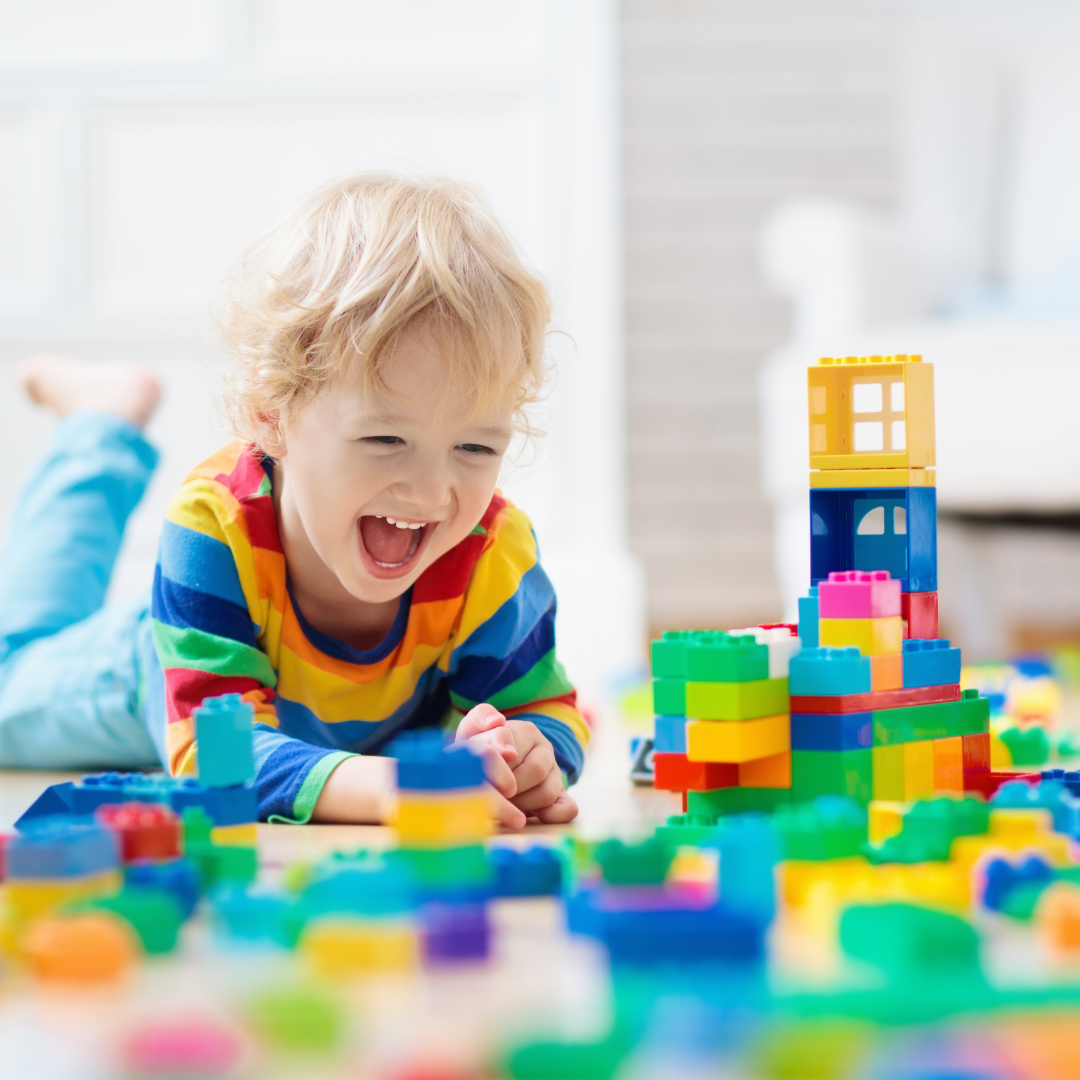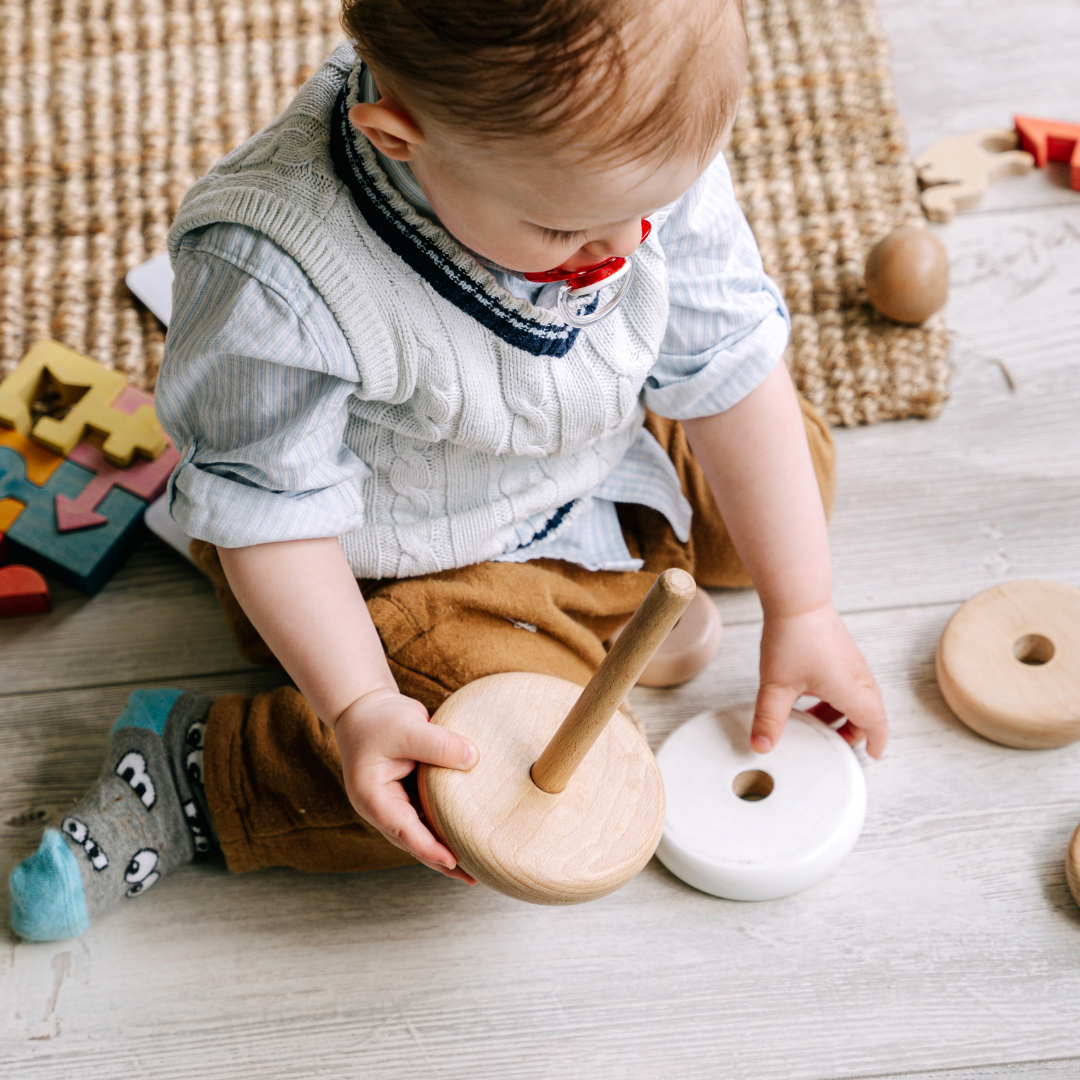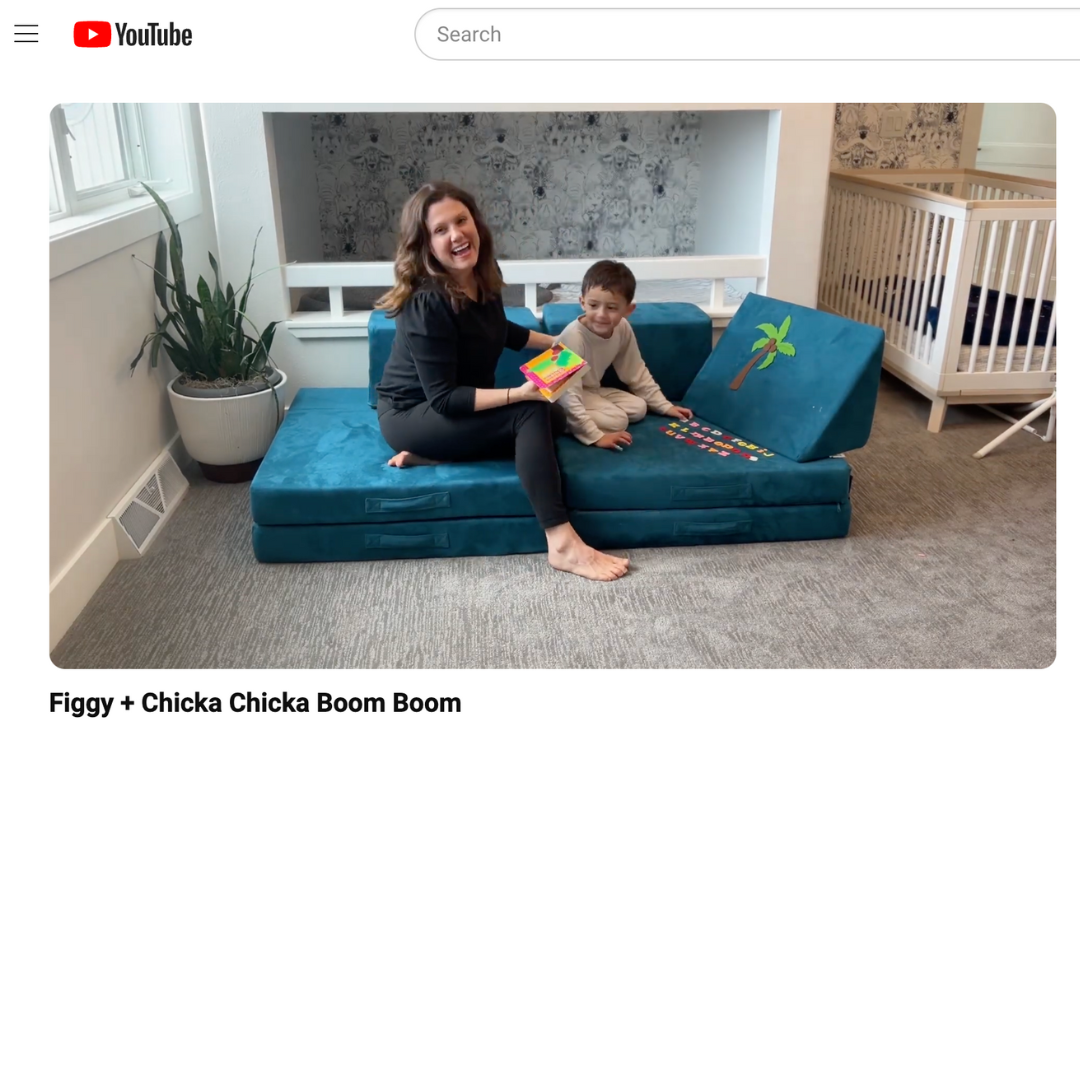Hi! Ann here from Figgy. While a room overflowing with stuffed animals might seem like a toddler's paradise, it also can be a parents mess nightmare. . Educational toys play a crucial role in child's development, fostering everything from motor skills to language development. If you're searching for the best toddler toys out there or wondering what to get that special kiddo for their birthday, look beyond the cute and cuddly and consider the power of educational toys that will make a difference!

Nurturing Little Minds Through Play
Here's a peek at the magic behind educational toys and how they benefit kids of various ages:
Building the Blocks of Development:
-
Fine Motor Skills: Toys like shape sorters, wooden blocks, and play kitchens with tiny utensils help toddlers develop the small muscle movements in their hands and fingers, crucial for tasks like writing and dressing later on. Think "Fisher Price" or a fun shape sorter you might find at "Pottery Barn Kids."
-
Gross Motor Development: Active play is essential for young kids! Ride-on toys like tricycles or a trusty "Skip Hop" pull-along toy encourage balance and coordination. Even something as simple as playing hide-and-seek gets those little bodies moving.
-
Hand-Eye Coordination: Musical toys like a kid-sized xylophone or bright colored stacking cups help toddlers refine the way their eyes and hands work together. These skills are important for future activities like catching a ball or learning to write.
Sparkling Creativity and Imagination
-
Open-Ended Toys: The best toys are those that spark creativity! Open-ended toys, like wooden blocks or a simple play dough set, allow kids to use their imaginations and come up with new ways to play each time.
-
Imaginary Play: Educational toys can fuel a child's imagination. A simple dollhouse or a set of wooden farm animals can turn a living room floor into a bustling farmyard or a royal palace, all fueled by a child's creativity.
-
Musical Toys: Music is a wonderful way to engage young minds. From singing along to board books with catchy tunes to banging on a kid-friendly drum set, musical toys can spark a lifelong love of music.
Learning Through Exploration
-
Language Development: Board books with bright pictures and simple stories are not just fun to read, they also help develop language skills. Pointing at pictures and naming objects is a great way to introduce young kids to new words.
-
Early Introduction to Concepts: Many educational toys introduce young kids to basic concepts like shapes, colors, and numbers. A simple shape sorter or a puzzle board with chunky pieces can be a great first step towards understanding these important concepts.
-
Problem-Solving Skills: Certain toys, like nesting dolls or stacking cups, require a bit of thought and problem-solving to figure out. These challenges help toddlers develop critical thinking skills that will benefit them throughout their lives.

Choosing the Right Educational Toy
With so many educational toys on the market, how do you pick the right one? Here are a few tips:
-
Consider your child's age and interests. A toddler who loves animals might enjoy a stuffed farm set more than a complex building set.
-
Think about safety. Make sure the toy is age-appropriate and free of choking hazards. Look for rounded corners and water-based paints on toys for younger children.
-
Focus on engaging play. The toy should be fun and engaging! If your child isn't interested, they won't learn much from it.
Where to Find Educational Toys?
You don't have to break the bank to find great educational toys. Many stores besides "Pottery Barn Kids" carry a wide selection engaging toys, including "Fisher Price" and other popular brands. You can also find a great selection online or even consider pre-loved toys from sites like Facebook Marketplace.
So next time you're on the hunt for the perfect "birthday gift" or wondering what toys are the best gifts for 1 year olds, look beyond just the fun factor. Educational toys can be the perfect way to combine playtime with learning, making them a great gift for any little one on your list!

The Power of Play: How Figgy Can Be an Educational Powerhouse
While many educational toys focus on specific skills, Figgy, the innovative play couch from https://figgyplay.com, offers a unique approach to learning through open-ended play. Here's how Figgy can be a beneficial educational toy for young kids:
Fostering Creativity and Imagination
-
Open-Ended Play at its Finest: Figgy's modular design, with separate base cushions and connectable pieces, allows kids to create endless configurations. One day it can be a cozy reading nook, the next a towering castle or a spaceship blasting off to outer space. This open-ended nature encourages imaginative play, a crucial element for a child's cognitive development.
-
Fueling Storytelling: The ability to create different scenarios with Figgy sparks storytelling. Kids can act out scenes from their favorite books, invent their own stories, or create elaborate role-playing scenarios. This imaginative storytelling helps develop language skills and self-expression.
-
Building and Problem-Solving: Figgy's versatility allows for building projects that require a bit of planning and problem-solving. Whether it's constructing a tall tower or a hidden fort, kids need to use spatial reasoning and critical thinking skills to bring their creations to life.
Beyond Imagination: Social and Emotional Learning
Figgy can also be a great tool for social and emotional learning:
-
Cooperative Play: Building and playing with Figgy often involves collaboration. Kids can work together to create a structure, negotiate roles in their imaginary play, and learn to share and take turns.
-
Emotional Expression: Figgy's various configurations can serve as a safe space for kids to express their emotions. A quiet fort might be a haven for a shy child, while a towering creation could represent feelings of power and accomplishment.
-
Sensory Exploration: Figgy's soft and inviting textures provide a wonderful sensory experience for young children. Climbing, cuddling, and building with Figgy can help toddlers develop their body awareness and sensory processing skills.
By encouraging open-ended play, imagination, and social interaction, Figgy goes beyond just a fun toy. It can be a valuable educational tool that supports a child's overall development in a playful and engaging way.

The Experts Weigh In: Why Educational Toys Matter
The benefits of educational toys are backed by research and echoed by child development professionals. Here's what the experts have to say:
-
The American Academy of Pediatrics (AAP) stresses the importance of play in a child's development. "Play allows children to use their creativity while developing their imagination, dexterity, and problem-solving skills. Play also provides opportunities for children to learn about themselves, their relationships, and the world around them."
-
Kathy Hirsh-Pasek, a renowned developmental psychologist at Temple University, highlights the role of educational toys in cognitive development. In an interview with The Greater Good, she emphasizes, "These toys don't have to be complicated or expensive. Building blocks, nesting dolls, and simple puzzles can all be great tools for helping young children develop important cognitive skills."
-
Lise Eliot, a neuroscientist and author of "What's Going On In There? How the Brain and Mind Develop from Conception to Adulthood," emphasizes the crucial window of early childhood development. In an article for Zero to Three she states, "During this time, the brain is like a sponge, absorbing information and experiences at an incredible rate. Educational toys can provide enriching experiences that help shape these developing neural connections."
Learning Through Laughter: Educational Songs to Enhance Playtime
Educational toys are a fantastic way to boost a child's development, but playtime doesn't have to be all about structured learning. Sing-alongs and musical activities can be just as enriching, especially when paired with engaging play. Here's how you can incorporate educational songs into playtime to make learning fun and interactive:
Action Songs Get Bodies Moving
Action songs are a classic way to get little ones moving and grooving. These energetic tunes often involve simple instructions that encourage children to follow along with physical movements. Here are some classic action songs to consider, along with some lyrics to get you started:
-
The Hokey Pokey (teaches body parts)
-
You put your right hand in,
-
You put your right hand out,
-
You put your right hand in,
-
And shake it all about.
-
You do the hokey pokey and you turn yourself around
-
That's what it's all about!
-
-
If You're Happy and You Know It (encourages emotional expression)
-
If you're happy and you know it, clap your hands!
-
If you're happy and you know it, clap your hands!
-
If you're happy and you know it, and you really want to show it,
-
If you're happy and you know it, clap your hands!
-
-
Head, Shoulders, Knees and Toes (reinforces body part identification)
-
Head, shoulders, knees and toes, knees and toes
-
Head, shoulders, knees and toes, knees and toes
-
Eyes and ears and mouth and nose, head, shoulders, knees and toes, knees and toes!
-
Sing Along and Learn
Many catchy songs go beyond silly movements and can introduce new concepts in a fun way. Here are some educational song ideas categorized by learning area, with the full lyrics to 3 songs to get you started:
-
Alphabet Songs:
The ABC song is a timeless classic, but there are many other alphabet songs available that introduce letter sounds and upper and lowercase letters in a sing-along format. Here's a catchy option:
-
Jingle Bells Alphabet Song
-
A you say apple, B you say ball, C you say cat and D you say doll,
-
E you say elephant, F you say funny, G you say giggle, H you say honey,
-
I you say ice cream, J you say jump, K you say kitty, L you say lump,
-
M you say monkey, N you say nest, O you say octopus, P you say pest,
-
Q you say queen, R you say rain, S you say silly, T you say train,
-
U you say umbrella, V you say vine, W you say wiggle, X you say xylophone,
-
Y you say yak, and Z you say zebra, Now you know your ABCs!
-
-
-
Counting Songs: Counting songs make learning numbers enjoyable. There are many options available, from simple counting songs like "One, Two, Buckle My Shoe" to more complex ones that introduce addition and subtraction. Here's a favorite with full lyrics:
-
Five Little Monkeys Jumping on the Bed
-
Five little monkeys jumping on the bed,
-
One fell off and bumped his head,
-
Mama called the doctor and the doctor said,
-
No more monkeys jumping on the bed!
-
Four little monkeys jumping on the bed,
-
One fell off and bumped his head,
-
Mama called the doctor and the doctor said,
-
No more monkeys jumping on the bed!
-
(Continue the song until no monkeys are left jumping on the bed)
-
-
-
Color Songs: Lively color songs can help toddlers identify and differentiate between different colors. Look for songs that incorporate actions like pointing to objects of specific colors in the room. Here's a paint-tastic option with full lyrics:
-
The Color Song by Laurie Berkner
-
Red and yellow and pink and blue,
-
Orange, purple, and green too!
-
Colors all around, can you find them?
-
Look up high and look down low
-
-

Dive Deeper: Recommended Books for Parents
Looking to expand your knowledge on the positive impact of music and songs during playtime? Here are some recommended books to delve deeper into the topic:
-
"The Mozart Effect for Children" by Don Campbell explores the potential of music to enhance a child's brain development. This book provides practical tips and suggestions for incorporating classical music into your child's life from infancy through adolescence.
-
"Help Your Kids with Music: A Unique Step-by-Step Visual Guide" by DK is a comprehensive resource for parents who want to introduce their children to the joys of music. This visually engaging book covers a variety of topics, including musical concepts, basic music theory, and tips for choosing age-appropriate instruments.
-
"Good Music Brighter Children: Simple and Practical Ideas to Help Transform Your Child's Life Through the Power of Music" by Christopher John Murray focuses on the practical application of music learning in a child's development. This book offers a wealth of ideas and activities that parents can use to integrate music into everyday routines and playtime.
Beyond the Building Blocks: Fun and Educational Activities for Toddlers
While educational toys can be a fantastic tool for learning, playtime shouldn't be limited to store-bought options! There are endless possibilities for creating fun and educational activities for toddlers right at home with everyday items. Here are some ideas to get you started, incorporating a variety of long-tail keywords to target specific interests:
-
Sensory Play for the Win: Sensory play is a fantastic way for toddlers to explore the world around them using their senses. Create a DIY sensory bin using a plastic tub filled with rice, beans, or pasta. Add colorful scoops, cups, and small toys for your little one to explore different textures. This is a great sensory play activity for toddlers learning about touch (tactile development).
-
Story Time Gets Messy: Reading books with your toddler is a wonderful way to introduce new vocabulary and concepts. Take story time a step further by incorporating some hands-on activities related to the book. For example, if you're reading a book about colors, you could create a simple color sorting activity with construction paper or washable paints. This is a fun way to combine educational apps for toddlers learning colors with a traditional story time activity.
-
Musical Instruments Made Easy: You don't need fancy instruments to get your toddler moving and grooving! Turn household items into musical instruments. Pots and pans become drums, plastic containers filled with rice or beans become shakers, and wooden spoons transform into rhythm sticks. This is a perfect example of music and movement activities for toddlers learning about sound and rhythm.
-
Nature's Playground: Head outdoors and explore the wonders of nature! Collect leaves, pinecones, and rocks for a nature scavenger hunt. This is a great way to get your toddler some fresh air while learning about the natural world. You can even extend this activity by creating a nature collage at home, incorporating some arts and crafts elements.
-
Shape Up with Playtime: Incorporate learning shapes into playtime with simple activities. Cut out different shapes from construction paper and have your toddler sort them into separate containers. You can also use cookie cutters with play dough to create different shapes. These activities can be used alongside best educational toys for toddlers 2 year old that focus on shape recognition.
These are just a few ideas to get you started. The possibilities for educational play with toddlers are truly endless! By using a little creativity and everyday items, you can create a fun and stimulating learning environment for your little one.
Choosing the Right Educational Toys: A Parent's Guide
With so many educational toys on the market, it can be overwhelming to choose the right ones for your toddler. Here are some tips to keep in mind:
-
Consider Your Toddler's Interests: Pay attention to what captures your toddler's attention. Are they drawn to building blocks, puzzles, or arts and crafts? Choosing toys that align with their interests will keep them engaged and motivated to learn.
-
Think Long-Term: Look for toys that can grow with your child. A set of nesting dolls can be used for simple stacking at a young age and progress to color and size recognition as your toddler develops.
-
Safety First: Always choose age-appropriate toys that are free from choking hazards and have smooth, rounded edges. Look for certifications like ASTM International (ASTM) or the Juvenile Products Manufacturers Association (JPMA) to ensure safety standards are met.
-
Quality Matters: Invest in well-made toys that will withstand enthusiastic toddler play. Durable toys will provide more value in the long run and can even be passed down to siblings or used for years to come.
-
Reviews and Recommendations: Don't hesitate to do your research! Read online reviews from other parents and check out resources like The New York Times Wirecutter's Best Gifts for 2-Year-Olds: to get expert recommendations on educational toys.
Remember, educational toys are just one piece of the puzzle. The most important aspect of learning through play is the interaction between you and your child. Get down on the floor and play with your toddler! Narrate your actions, ask questions, and most importantly, have fun together!

